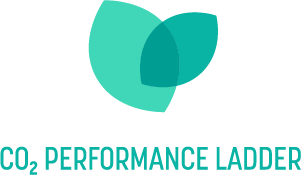CO2 Performance Ladder

We achieved CO2 Performance Ladder level 3
Achieving the CO2 Performance Ladder level 3 demonstrates that we are taking proactive steps to reduce our CO2 emissions and promote sustainable business practices. On this page, we explain what it means to achieve the CO2 Performance Ladder Level 3 certificate. In addition, we provide insights into the concrete measures we are taking to reduce our carbon footprint.
Level 3 : Excellent rating for manufacturing companies
Although level 5 is the highest attainable step, it is significantly more ambitious and challenging to achieve when certifying the entire production process of artificial grass rather than just certifying a distribution location or installation phase. We chose this ambitious path and are proud to have reached level 3 on the CO2 Performance Ladder certificate. This certification covers the entire production process, meaning it applies not only to laying artificial grass but to the entire proces of realising your sports infrastructure.
What does this CO2 certificate mean for you
 Choosing an artificial turf company certified at level 3 helps you contribute to national and European climate targets. The EU has set specific climate goals for reducing greenhouse gas emissions. Selecting artificial turf from a company certified with the CO2 Performance Ladder, sports clubs and municipalities demonstrate their commitment to carbon reduction. This choice also enhances your public image with other municipalities and current or potential club members, creating the opportunity to make your project or club more attractive to investors.
Choosing an artificial turf company certified at level 3 helps you contribute to national and European climate targets. The EU has set specific climate goals for reducing greenhouse gas emissions. Selecting artificial turf from a company certified with the CO2 Performance Ladder, sports clubs and municipalities demonstrate their commitment to carbon reduction. This choice also enhances your public image with other municipalities and current or potential club members, creating the opportunity to make your project or club more attractive to investors.
How we achieved and keep level 3
1. Map our scope 1 2 3 carbon emissions on anual basis
We map our organization’s carbon footprint annually. This includes not only direct emissions from fuel consumption but also indirect emissions from procuring goods and services.
Our total carbon footprint was 2332 tonnes of CO2 in 2022 and 1557 tonnes in 2023. Here’s an overview of our footprint per scope for each year:
Carbon footprint 2023 - share by scope
Carbon footprint 2022 - share by scope
2. Set scope 1 2 3 carbon reduction targets
We formulated concrete targets for reducing CO2 emissions. Hereby the targets for Domo® Sports Grass:
| Category | Target compared to reference year 2022 |
|---|---|
| Scope 1 + 2 + Business Travel | 25% reduction by 2025 |
| Scope 1 + 2 + BT + Employee commuting | 40% reduction by 2030 Climate neutral by 2050 |
| Green electricity / fuels | Purchasing 100% green electricity from 2023 |
To achieve the big targets by 2025 and 2030, we would need to achieve annual reduction targets for scope 1 2 3 carbon emissions:
| Category | 2023 (vs 2022) | 2024 (vs 2022) | 2025 (vs 2022) |
|---|---|---|---|
| Scope 1 | -1% | -3% | -5% |
| Scope 2 | -10% | -15% | -18% |
| Business Travel (Scope 3) | -1% | -1% | -2% |
3. Implementing CO2 reducing actions
To achieve our carbon reduction targets for scope 1 2 3 carbon emissions and maintain these target values, we have implemented the following actions:
Scope 1
- Simple actions by our colleagues: switching off lights and appliances at the end of the working day, not leaving doors and windows open in winter, sorting waste and making sustainable material choices.
- Heat recovery to reduce gas consumption
- Switch latex to Domo® Infinitum coating (reduction gas emission for oven)
- Switch to more sustainable vehicles and equipment
- Measures relating to the gas and fuel consumption of the company's fleet
- Waste is responsibly handled and collected by a suitable waste disposal partner
Scope 2
- Home-generated energy from solar panels, supplemented by green electricity
- Phased installation of LED lighting in all our buildings
Scope 3
- Choose lower-emission flights when travelling by air
- Encourage employees to use alternative transport for shorter journeys
- Increase the use of remote meetings
- Encourage people who live less than 10 km from work to cycle to work
4. Communicating and reporting
To reach our goals, staff participation is essential. Therefore, communication with them is necessary. Internally, they are taught the actions they can take to contribute to our objectives. Externally, we ensure transparency through our website, showcasing our certificate and supply chain initiatives:
- Our company page on SKAO
- Our Performance Ladder level 3 certificate
- Supply Chain initiative document
Taking these steps enables us to achieve and maintain the CO2 Performance Ladder certificate, demonstrating our genuine commitment to reducing our climate impact. This certificate not only proves our efforts but also motivates us to continuously improve and strive for excellence.
What is the CO2 Performance Ladder
The CO2 Performance Ladder certificate serves as a tool for companies and organisations to reduce their scope 1, 2, and 3 carbon emissions while promoting sustainability. It not only provides an advantage in tender registrations but also functions as both a CO2 management system and a procurement tool.
Becoming certified with the CO2 Performance Ladder is an investment that offers immediate return in reduced energy costs, material savings, and innovation. The primary goal is to drive organisations to gain insights into their carbon emissions and continuously seek opportunities to minimise them across projects.
The ladder comprises various levels, with step 5 being the most ambitious in CO2 reduction. Companies are certified at a specific step based on their performance in CO2 reduction and sustainability efforts.
More information on: What is the Ladder (co2-prestatieladder.nl)
How do we enable carbon reduction in our way of working?

Feel free to contact us
Do you have more questions about our carbon reducing plans? Or do you want more information about how the CO2 Performance Ladder works?
Fill in the form below and your representative will contact you shortly.
Frequently asked questions
What are scope 1 2 3 carbon emissions?
Scope 1 emissions include direct emissions from sources that are either owned or under the direct control of the reporting organisation. These emissions typically result from on-site activities such as the combustion of fossil fuels in company-owned vehicles, industrial processes and heating systems.
Scope 2 emissions include the indirect emissions associated with the generation of purchased energy used by the reporting organisation. These emissions are not generated on-site, but result from the production of the electricity or heat consumed by the organisation.
Scope 3 emissions represent a broader category of indirect emissions that are not covered by either Scope 1 or Scope 2. They cover the organisation's entire supply chain and product lifecycle, providing a more comprehensive view of its environmental impact.
Source: European Central Bank. (2022, 29 july). ECB Environmental Statement 2022. https://www.ecb.europa.eu/ecb/climate/green/html/ecb.environmentalstatement202207~dedabd566b.en.html
What is the meaning of direct emissions
Direct emissions are green house gas emissions (GHG) coming from sources that are owned or controlled by the reporting organisation. These emissions are typically created from on-site activities such as the manufacturing of goods, energy sources, transportation, and other industrials processes. Direct emissions fall under scope 1.